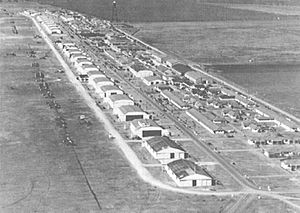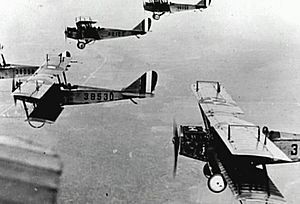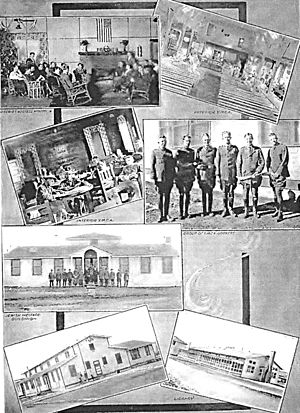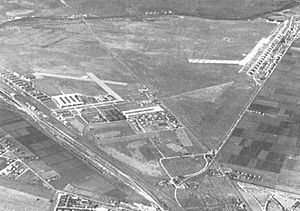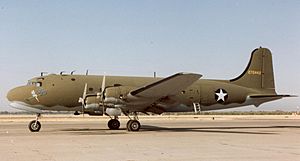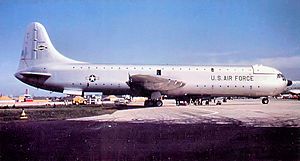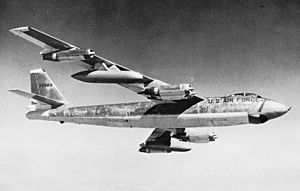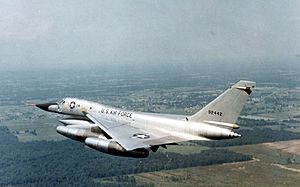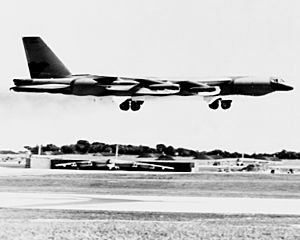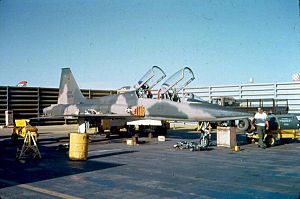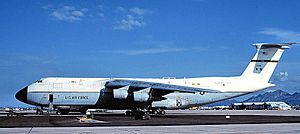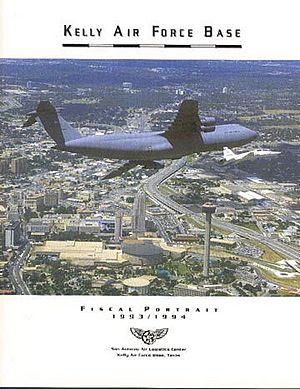Kelly Field facts for kids
Quick facts for kids Kelly Field |
|||||||
|---|---|---|---|---|---|---|---|
| Part of Joint Base San Antonio | |||||||
| San Antonio, Texas in the United States | |||||||
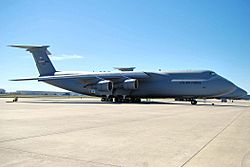
A US Air Force C-5 Galaxy of the 433rd Airlift Wing at Kelly Field during 2011
|
|||||||
 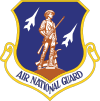 |
|||||||
| Coordinates | 29°23′00″N 098°34′51″W / 29.38333°N 98.58083°W | ||||||
| Type | US Air Force airfield | ||||||
| Site information | |||||||
| Owner | Department of Defense | ||||||
| Operator | United States Air Force | ||||||
| Controlled by | Air Education and Training Command | ||||||
| Condition | Operational | ||||||
| Site history | |||||||
| Built | 1917 | ||||||
| In use |
|
||||||
| Garrison information | |||||||
| Occupants |
|
||||||
| Airfield information | |||||||
| Identifiers | IATA: SKF, ICAO: KSKF, FAA LID: SKF, WMO: 0722535 | ||||||
| Elevation | 210.4 metres (690 ft) AMSL | ||||||
|
|||||||
Kelly Field (once known as Kelly Air Force Base) is an airfield in San Antonio, Texas. It is a "Joint-Use" facility, meaning it's used by both military and civilian groups. The field was named after George E. M. Kelly, who was the first U.S. military member to die in an airplane crash while flying.
In 2001, Kelly Air Force Base changed. Its runway and the land west of it became "Kelly Field." This smaller area then became part of Lackland Air Force Base, which is part of Joint Base San Antonio. The 802d Mission Support Group, under the Air Education and Training Command (AETC), now manages the base.
Kelly Field was one of many training camps set up for the Air Service when the United States joined World War I on March 27, 1917. It was used for flying lessons, a primary flying school, and a school for officers and engineers. It also served as a mechanics school and a large supply center for aviation.
Kelly Air Force Base and its San Antonio Air Logistics Center were officially closed as a separate base in 1995. Its operations were then reorganized.
Contents
Kelly Field Today
Kelly Field is still very active! It supports flight operations for two main groups. The Air Force Reserve Command's 433d Airlift Wing flies the huge Lockheed C-5 Galaxy cargo planes here. Also, the Texas Air National Guard's 149th Fighter Wing operates its General Dynamics F-16 Fighting Falcon jets from Kelly Field.
The rest of the land, about 1,873 acres, used to be the San Antonio Air Logistics Center. Now, it's managed by the Port Authority of San Antonio (formerly the Greater Kelly Development Authority). This area is a big business park called Port San Antonio. As of 2006, some U.S. Air Force activities still happen there, and there are military family homes.
In September 2005, large warehouses at Port San Antonio were used to help people. They were cleaned and set up with air conditioning to house people who had to leave their homes because of Hurricane Katrina and Hurricane Rita.
Kelly Field's History
Kelly Field is named to honor 2nd Lieutenant George Edward Maurice Kelly. Lt. Kelly trained at the Curtiss Aviation School in California. He was then sent to Fort Sam Houston near San Antonio. On May 10, 1911, he died in a plane crash. He was trying to land safely and avoid hitting a tent, which could have hurt others.
How Kelly Field Started
In August 1913, a U.S. Army officer named Brigadier General George P. Scriven spoke about building a military aviation center in San Antonio, Texas. This center was for the Aviation Section of the U.S. Army Signal Corps. General Scriven said San Antonio was a very important location. This was because of problems happening during the Mexican Revolution. In 1916, a local newspaper said San Antonio would become "the most important military aviation center in the U.S."
In November 1915, the new 1st Aero Squadron arrived at Fort Sam Houston. They had flown all the way from Oklahoma. But they only stayed until March 1916. Then, they left to join Brigadier General John J. Pershing's mission against Pancho Villa near the U.S.-Mexico border. The problems the 1st Aero Squadron faced, along with the ongoing World War I in Europe, made Congress decide to improve the nation's air force.
It quickly became clear that Fort Sam Houston didn't have enough space for more flying operations. This was especially true with newer, more powerful airplanes. On November 21, 1916, Major Benjamin Foulois chose a new site for an airfield. It was five miles southwest of the city. The new site was next to the Southern Pacific Railroad, making it easy to get to by road and train. It was also flat, which was perfect for flying. At first, this new place was called the South San Antonio Aviation Camp.
World War I Training Hub
On April 5, 1917, four planes flew from Fort Sam Houston and landed at the new airfield. It was just a cleared cotton field back then. Tents were used as hangars. But a permanent base wasn't set up until May 7, when 700 men arrived. A week later, there were 4,000 people there! The base was built very quickly because the U.S. was now at war. The main goal was to train pilots to send to France. Workers cleared the land and built many buildings, like hangars, barracks, and workshops, during that summer.
By the end of June, it was clear that the first site, unofficially called Kelly Field #1, was too small. It couldn't train both new recruits and pilots at the same time. The San Antonio Chamber of Commerce helped get more land for what became Kelly Field #2. Two more areas, planned as Kelly Field #3 and #4, were later released. This was because British and French pilots thought having too many fields so close together would cause accidents.
During 1917 and 1918, soldiers at Kelly helped organize about 250,000 men into "Aero Squadrons." In total, 326 squadrons were formed at Kelly during World War I. Most of these moved to other bases or overseas. Kelly Field was the first place where new recruits were tested and assigned to specific jobs and training groups. The Air Service Mechanics School trained about 2,000 mechanics and drivers each month. Kelly also trained cooks and bakers. The main aviation supply depot also moved to the field.
Many American pilots trained for World War I at Kelly Field. A total of 1,459 pilots and 398 flying instructors graduated from Kelly's aviation schools during the war.
After training at Kelly, most pilots went to France for more advanced training. Other pilot training happened at Selfridge Field in Michigan. The British Royal Flying Corps (RFC) also ran flying schools for American pilots in Canada and Texas.
The thousands of soldiers at Kelly found many ways to have fun in their free time. They had a glee club, a minstrel show, and a group called the "Famous Kelly Field Players." This group was made up of professional entertainers who were in uniform. Many of these groups traveled around South Texas, making people happy with their shows.
Between the World Wars
After World War I, the Army Air Service became much smaller. Thousands of officers and soldiers left, leaving only 10,000 people to fly and fix planes. Many small airfields closed, and supply and repair centers were combined. But Kelly was one of the few that stayed open.
In 1919, the U.S. House of Representatives approved money to buy more land at military camps that would become permanent bases. Kelly Field No. 2 received a large part of this money.
In 1921, an aviation repair depot from Dallas moved to Kelly. It joined with the supply depot, forming the San Antonio Intermediate Air Depot.
Brooks Field became the main place for basic pilot training, while Kelly focused on advanced training. Most Army pilots trained between the two World Wars went to Kelly's advanced school. Charles Lindbergh, the first person to fly solo across the Atlantic, graduated from Kelly's Advanced Flying School in 1925. Other famous graduates included future Air Force Chiefs of Staff. Major General Claire Lee Chennault, known for the "Flying Tiger" group in World War II, also taught at the school.
In 1925, Kelly Field #1 was renamed Duncan Field to honor Lieutenant Colonel Thomas Duncan. He had worked at Kelly Field and died in a plane accident. Kelly Field #2 then became simply Kelly Field. For the next 18 years, both fields operated separately for training, maintenance, and supply.
Even with low pay and old planes, the mechanics and pilots kept working hard. They helped advance aviation in the 1920s. For example, the plane Jimmy Doolittle used for his 1922 flight across the country was serviced at Kelly #1. Kelly #2 was Doolittle's only stop to refuel during that flight. In 1926, Kelly was the starting point for the Pan American Goodwill Flight. This was a 175-day trip to show the American flag, with five planes and 10 pilots visiting 23 countries in Central and South America. Captain Ira C. Eaker, a Kelly graduate who led the 8th Air Force in World War II, was one of these pilots.
Much of the early work on instrument flying happened at Kelly. Major William Ocker and Captain Charles Crane developed the first "blind flying" lessons there. Crane even won an award for his efforts.
People loved watching "daring young men in their flying machines." Army pilots at Kelly often showed off their skills to help people see airplanes as important for America's future. Air shows and balloon races were exciting events in the 1920s. Kelly hosted the National Elimination Balloon Race in 1924, bringing thousands of San Antonio residents to see the take-offs and air demonstrations.
Perhaps the most exciting event was the filming of the Hollywood movie Wings in 1926. Kelly helped make movie history by providing pilots, planes, and technicians for this World War I film. Famous actors like Clara Bow and Richard Arlen starred in this silent movie, filmed around San Antonio. A young actor named Gary Cooper also had a small part. Wings won the first Academy Award for "Best Production of the Year" in 1927–1928. It was the only silent film to win this honor until 2011.
In 1927, basic training moved out of the advanced phase and combined with primary training. This made primary-basic training eight months long and advanced training four months. In June 1927, General Lahm suggested building one large field outside the city for all flying training. Congress funded the new field's construction. The city of San Antonio borrowed money to buy the land for what became Randolph Field. By late 1931, construction was mostly done. The Air Corps Training Center at Duncan Field, next to Kelly, and the primary schools at Brooks and March moved to the new base. Advanced training stayed at Kelly.
The Air Corps always struggled with not enough money for better planes. This changed after the 1938 crisis over Czechoslovakia. Adolf Hitler and the Luftwaffe (the German Air Force) showed that air power was very important in world affairs. President Franklin D. Roosevelt realized this and started to rebuild the United States military.
In 1939, Congress approved $300 million for the Air Corps. Hundreds of new planes, officers, and soldiers came to Kelly. Money also became available for much-needed barracks, offices, classrooms, and warehouses. Many buildings from this time are still used today. The current Officer's Club and the Air Logistics Center headquarters were built during this expansion.
In the summer of 1942, Duncan Field and Kelly Field merged to form Kelly Field. This happened because flying conditions were becoming dangerous due to four airfields (Duncan, Kelly, Brooks, and Stinson) being too close together.
Other buildings from this construction boom included the unique Miniature Range building, used for aerial observation training. There was also the "Palace," a huge complex for soldiers' living quarters, dining halls, and offices. It was nicknamed "Buckingham Palace" because it was so much grander than the tents and simple wooden barracks the men had lived in before.
World War II Efforts
After Japan attacked Attack on Pearl Harbor on December 7, 1941, the U.S. needed many more pilots, bombardiers, and navigators. This led to a quick expansion of the Army's air force and the Advanced Flying School. Night flying was added, and training time doubled. Between January 1939 and March 1943, over 6,800 men graduated from Kelly's Advanced Flying School. About 1,700 more pilots graduated from other instructor courses. To house all the new pilot trainees, a "tent city" appeared, just like in World War I.
By the summer of 1942, flying became dangerous because four airfields—Duncan, Kelly, Brooks, and Stinson—were too close. So, in March 1943, Kelly and Duncan were combined again under the name Kelly Field. Kelly Field's main jobs then became maintenance and supply. This was a big change, as flight training moved to other places.
Kelly's role in World War II turned the base into a huge industrial center. A new group, the San Antonio Air Service Command, managed the increased supply and maintenance work. This group later became the San Antonio Air Logistics Center. Workers at Kelly repaired and updated aircraft, engines, and other equipment.
After the War
When World War II ended in August 1945, America quickly reduced its military, just like after World War I. Over 3,000 civilian workers at Kelly left their jobs within weeks. Still, more and more AT-6, P-51, and B-29 aircraft were sent to Kelly for maintenance and storage. Kelly's workers spent more and more time on aircraft disposal and storage programs. They stopped repairing large bombers and started supporting forces in Europe and Japan with air transport, communications, and weather systems. In 1946, the San Antonio Air Technical Services Command became the San Antonio Air Materiel Area (SAAMA).
In July 1947, President Harry S. Truman signed the National Security Act. This law created an independent United States Air Force. Over the next few years, the Air Force separated from the Army. In January 1948, Kelly Field became Kelly Air Force Base.
Berlin Airlift and Korean War Support
By June 1948, the Soviet Union blocked all roads, rails, and water routes into West Berlin. To avoid giving up West Berlin, the Western powers started an airlift. They flew in all the necessary supplies and materials to the city around the clock. This airlift, called "Operation Vittles," was the biggest air cargo operation ever. The main plane used was the C-54 Skymaster cargo aircraft. Kelly was the only place in the country that repaired and updated the Pratt and Whitney R2000 engines used on these planes. By December 31, Kelly had shipped 1,317 R2000 engines for the airlift.
When the Korean War started in June 1950, Kelly quickly responded. The maintenance line at Kelly worked at full speed to get Boeing B-29 Superfortress bombers, which had been stored, ready for overseas service. Work continued into the night using special outdoor lights. The aircraft production line was nicknamed the "Great White Way" because the lights reflected off the bombers' aluminum skin and lit up the night sky. When the fighting in Korea ended in July 1953, Kelly workers had once again shown their dedication.
The 1950s at Kelly
As the Air Force grew, its planes, engines, and equipment became more complex. This required new technologies and programs.
By 1951, the Convair B-36 Peacemaker bomber started arriving at Kelly in large numbers. With its powerful R4360 engines, the B-36 quickly replaced the B-29. The B-36 was a unique design; its six engines pushed it to over 400 miles per hour. It was the first American bomber that could reach any target in the world.
The R4360 engines also powered the Convair XC-99. This one-of-a-kind transport plane was built in 1947. It was the largest cargo plane at the time and set many world records between 1953 and 1955. The longest flight was 12,000 miles to Rhein-Main Air Base in West Germany, starting on August 13, 1953. It carried 61,000 pounds of cargo and returned a week later with another 62,000 pounds. Everywhere the XC-99 landed, reporters were there to share the excitement of the flight.
Another record flight happened in May 1955. The XC-99 helped with PROJECT DEWLINE. It airlifted 380,000 pounds of cargo to Keflavik Airport, Iceland, from Dover Air Force Base, Delaware. This was a distance of 2,500 miles. The plane was in the air for over 210 hours. Even with some problems, 31 civilian technicians from the San Antonio depot successfully repaired the XC-99.
Jet engines became very important to the Air Force by 1955. The Boeing B-47 Stratojet bomber was the first full jet bomber. Designed in 1945, the B-47 had six General Electric J47 turbojet engines and swept-back wings. Its job was to deliver bombs to enemy targets. On November 30, 1959, a B-47 bomber set a world record, staying airborne for over three days and covering 32,900 miles. The last B-47s were removed from active service in 1966.
The Convair B-58 Hustler was another important addition. As America's first supersonic bomber, it could fly higher and faster than any other bomber, at twice the speed of sound. Its four J79 engines produced over 41,000 pounds of thrust, pushing the sleek bomber at more than 1,300 mph. The first B-58 arrived at Kelly on March 15, 1960. It was used to train maintenance staff for the new overhaul work. On May 26, 1958, SAAMA opened the B-58 Logistics Support Management Office. This was a step towards separating worldwide weapons management from internal depot operations.
Kelly repaired and updated B-52s for over 30 years. In the early 1960s, the Boeing B-52 Stratofortress was the main maintenance job for SAAMA. Changes made to the B-52s at Kelly increased their cargo capacity and flying range. Also, the shops in San Antonio painted the B-52Gs in camouflage for Southeast Asia Arc Light missions. This long relationship between Kelly and the B-52 ended in 1993 when the work moved to Tinker Air Force Base in Oklahoma.
Kelly's involvement in space exploration has been ongoing for over 25 years. In August 1962, SAAMA "loaned" six aircraft to NASA. This allowed astronauts at Houston's Manned Spacecraft Center to keep their flying skills sharp. Two years later, workers built three Apollo capsule trainers for NASA. And Kelly's Aerospace Fuels team supplied NASA with the necessary liquid fuels from the very start of the Space Administration's journey into space.
Vietnam War Support
Kelly's work stayed steady until the mid-1960s, when the U.S. became directly involved in Vietnam. After the Gulf of Tonkin incident in August 1964, all air materiel areas, including Kelly, started supporting Southeast Asia 24 hours a day. For the next 11 years, Kelly employees were deeply involved in providing parts and expertise for the conflict, both in the U.S. and overseas.
In May 1965, during the build-up of American forces in Vietnam, the Logistics Command began sending supply teams to the Pacific Air Forces. Many people from Kelly volunteered. By December 31, 1965, SAAMA had sent 11 supply teams, totaling 89 people, to Southeast Asia. Their job was to set up supply centers across the western Pacific, including South Vietnam.
Kelly also sent maintenance teams to Southeast Asia. The first team of six jet engine mechanics worked at Clark Air Base, Philippines, on J57 engines for North American F-100 Super Sabres. Other Kelly workers helped with special Northrop F-5 Freedom Fighter modifications in South Vietnam. They also helped put together newly shipped F-5A/C aircraft at Bien Hoa Air Base and set up an engine repair facility there. Some workers helped with quick maintenance support or transportation, while others served as weapon system logistics officers. Those who stayed in San Antonio also worked hard to meet the demands for materials and aircraft maintenance.
On July 1, 1965, Kelly became an aerial port. This meant it could provide direct cargo service to Southeast Asia. Kelly Air Force Base personnel processed and sent important war materials to the Southeast Asian Theater. By 1967, the U.S. build-up increased. The Lockheed C-141A Starlifter cargo aircraft started to arrive in large numbers, replacing the older Douglas C-124 Globemaster II. With modern air terminals and more C-141 aircraft, Military Airlift Command (MAC) crews rarely faced delays at Kelly's aerial port.
On November 1, 1965, SAAMA took over the Air Force's entire watercraft program. This included all types of landing vessels, spare parts, engines, and combat ships. It also covered cargo tanks, special service vessels, barges, small boats, and marine hardware. Earlier that year, on August 3, Kelly became responsible for putting together and shipping airfield lighting equipment. This was to set up four semi-fixed installations in Southeast Asia.
In the early 1970s, the Vietnamization Program began. This new policy aimed to reduce U.S. military forces in South Vietnam. As part of this, SAAMA personnel were deeply involved in planning and building an engine facility at Bien Hoa Air Base. This task started in February 1971 when the Air Force Logistics Command asked SAAMA to create full plans for turning an existing building at Bien Hoa Air Base into an engine overhaul facility.
One month later, the San Antonio Air Materiel Area became involved in another project to provide logistics support. On October 20, 1972, SAAMA started PROJECT ENHANCE PLUS. This project transferred A-37, Northrop F-5E Tiger II, and Northrop T-38 Talon aircraft, engines, and spare parts to the Republic of Vietnam. This was to help them continue the war after American forces left. Almost every department at Kelly helped with this effort.
The C-5A Galaxy, the Air Force's largest aircraft, joined the fleet in June 1970. The San Antonio Air Materiel Area was responsible for managing and repairing this giant transport and its TF39 engine. Weighing about 350 tons, the aircraft can carry 98 percent of the equipment issued to an Army division. This includes the 100,000-pound M-1 tank, self-propelled artillery, missiles, and helicopters. When it first visited Kelly on January 31, 1970, important people and the public greeted the C-5A.
A year before the U.S. ended its involvement in Southeast Asia, the military started preparing for the return of Prisoners of War held by North Vietnam. When the Paris Peace Accords were signed on January 27, 1973, "Operation Homecoming" began. The prisoners were flown from North Vietnam to the reception center at Clark Air Base, Philippines. There, they had medical checkups, received uniforms, and made important phone calls home. After a short stay, they flew to the United States to reunite with their families and get full medical and psychological care. Lackland Air Force Base and Fort Sam Houston in San Antonio were chosen as reception areas because they had hospitals. Kelly became the main arrival point for these flights. Flights bringing the former POWs to Kelly began on February 15, 1973. Although crowds were kept small, the events were full of joy. The 11 flights that arrived at Kelly carried 20 Air Force and 12 Army men. Kelly Air Force Base was very proud to welcome home these brave men.
After Vietnam
In 1974, the San Antonio Air Materiel Area changed its name to the San Antonio Air Logistics Center. But its dedication to the Air Force mission stayed the same.
The first F100 engine arrived at the SA-ALC on August 9, 1974. This engine was mainly used for training. It also served as a test engine to check if repair plans, technical data, tools, and equipment were good enough. Managing and maintaining the F100 is complex because of its unique design. The engine is split into five parts called modules. If a module was faulty, it could be removed and replaced quickly to get the engine back in service. Another special feature of the F100 engine was "on-condition" maintenance. This meant if an inspection team found that the other modules were working well, only the broken part would be fixed, and the rest of the engine would be left alone. Also, the time between overhauls was measured by "cycles" (how often the engine throttled up and down), not just flight hours.
Even though the C-5A was good, Lockheed and the Air Force planned to make the large cargo plane more reliable and easier to maintain. This led to the creation of the C-5B in the early 1980s. The C-5B fleet added a lot more cargo capacity to the U.S. military's airlift abilities.
On November 16, 1973, the Aerospace Fuels team provided fuel support for the last Skylab space program launch. In March 1979, the Space Shuttle "Columbia" arrived at Kelly Air Force Base for the first time. It was on top of a Boeing 747 and stopped for refueling on its way to Kennedy Space Center in Florida. This was Kelly's most dramatic and visible support for the space program, but not its last. NASA flights continued to land with parts and equipment for many Space Shuttle missions, heading to Kennedy Space Center, as late as June 2009.
The San Antonio Air Logistics Center also managed the new Boeing C-17 Globemaster III. This advanced aircraft was designed in the late 1980s to be a tough, reliable, and modern airlifter. It was built to meet the needs of the Army, Marines, and Air Force. The C-17 gives U.S. combat commanders more flexibility to get to battles faster and win. Kelly's role in the C-17 program grew when the Air Force Logistics Command named it the main repair center for the aircraft's body. In March 1985, Kelly's involvement became almost complete when it was given the job of managing and repairing the C-17 engines, the Pratt & Whitney F117-PW-100 turbofans.
When B-52 repair work moved to Oklahoma City in 1993, Kelly's workers focused on keeping the T-38 jet trainers of the Air Education and Training Command ready to fly. This work moved to Kelly in the spring of 1993.
Base Closure
During Operation Just Cause, Kelly was a key stop for over 8,200 troops going to Panama. It also received about 250 wounded service members. Later, the base moved over 10,000 tons of material and 4,700 passengers. It also sent 17 million pounds of ammunition to Southwest Asia for Operation Desert Storm. In the 1990s, Kelly supported U.S. operations in Kosovo.
In 1992, a major defense reorganization changed who owned most of Kelly's warehouses. Ownership shifted from the Air Force to the new Defense Logistics Agency. The next year, the Base Realignment and Closure Commission listed Kelly and three other logistics centers for closure. Local officials managed to save the base for a short time.
Kelly Air Force Base was closed because the Base Realignment and Closure Commission in 1995 decided its work should be combined with other Air Force depots. Parts of the base were moved to Lackland Air Force Base. A large part became Port San Antonio. Before it closed, Kelly was a very important part of San Antonio. For example, it hosted Air Force One's backup plane in 1998. After the closure, labor disputes at Air Force maintenance centers dropped by 50%.
On April 1, 2001, the 37th Training Wing at Lackland AFB, Texas, took over the Kelly AFB flightline and the area west of the runway. This area was then called Kelly Field Annex.
Port San Antonio (formerly known as KellyUSA) has now renamed the logistics center Port San Antonio. This name fits its goal of becoming the largest inland port in South Texas.
Facility Names Over Time
- Aviation Camp (also called Remount Station) at Fort Sam Houston, around February 1917
- Camp Kelly, June 11, 1917
- Kelly Field, July 30, 1917
- Kelly Air Force Base, January 29, 1948 – September 30, 2001.
- The flightline and airfield area became: Kelly Field Annex (part of Lackland AFB)
- The main station area was given to civilian control.
Major Commands Assigned to Kelly
- Aviation Section, Signal Corps, May 1917
- Division of Military Aeronautics, April 27, 1918
- Air Service, United States Army, August 27, 1918
- United States Army Air Service, July 1, 1920
- United States Army Air Corps, July 2, 1926
- Air Corps Training Center, September 1, 1926
- Renamed: Gulf Coast Air Corps Training Center, July 8, 1940
- Gulf Coast Army Air Forces Training Center, May 1, 1942
- Air Service Command, March 11, 1943
- Army Air Forces Materiel and Services Command, July 17, 1944
- Renamed: Army Air Forces Technical Service Command, August 31, 1944
- Air Technical Service Command, July 1, 1945
- Air Materiel Command, March 9, 1946
- Air Force Logistics Command, April 1, 1961
- Air Force Materiel Command, June 1, 1992 – September 30, 2001
Other Locations Connected to Kelly
- Kelly Field #1: South of Kelly Air Force Base, acquired 1917. Together with Kelly Field #2, it was named Duncan Field on March 13, 1925. It combined with Kelly Field on March 2, 1943.
- Kelly Field #2 (also called Pampa Air Force Auxiliary Field #2): South of Kelly Air Force Base, acquired 1917. Combined with Kelly Field #1 and named Duncan Field, March 13, 1925.
- Kelly Field #3: 2 miles East of Castroville, Texas. Acquired early 1939, transferred to Hondo Army Air Field, Texas, February 12, 1943.
- Kelly Field #4: 9 miles Northwest of Kelly AFB. Acquired June 1, 1939, transferred to Brooks Field, February 12, 1943.
- Kelly Field #5: 6 Miles South-Southeast of San Antonio, Texas. Was Gosport Field, a civilian airport, acquired early 1917, Renamed: Brooks Field, February 4, 1918.
See also
- List of American Aero Squadrons
- Texas World War II Army Airfields
- Lackland Air Force Base
- United States Army World War I Flight Training






